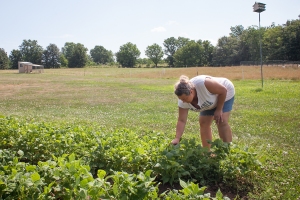
Axel, center, one of the Boer goats that Deanna Davis owns receives an identification tattoo on one of his ears on July 17, 2013, in Boonville, Mo. Davis has several vegetable gardens on her property where she and her family also raise chickens and meat goats. (Catalin Abagiu/ MUJW)
Story by Dylan Johnson, Lee’s Summit West High School
COLUMBIA — Organic foods are often considered healthier for the body and better for the environment, but they also can lighten a wallet at checkout.
Some people might wonder why organic foods seem to have higher prices than more traditionally grown vegetables, diary, fruits and meat at supermarkets, and the answer starts with the farmer.
“Always ask yourself: Where is (your food) coming from?” said Bill McKelvey, project coordinator for the Food Pantry Nutrition Project at MU.
Organic farming requires more physical labor to maintain higher environmental standards; therefore, farmers have to hire more workers to hand-weed the plants and other labor-intensive chores, according to the Environmental Working Group, a national environmental health research organization.
The U.S. Department of Agriculture, which regulates standards for certified organic crops, doesn’t allow organic farmers to inject any chemicals in their crops.
Deana Davis, co-owner of the Imhoff Family Farm in Boonville, said the farm’s vegetables, chicken eggs, goat meat and milk are organically grown but aren’t certified by the USDA.
“It’s our cost,” said Davis. “Chicken can cost $8.50 because you are using about 60 percent of the chicken.”

Davis tends to a vegetable garden on her property, where she has several vegetable gardens. (Catalin Abagiu/MUJW)
Davis learned about farming by observing the Amish and Mennonite communities in the area. “There are natural ways to do everything,” she said.
When farming organically, Davis said, everything is used for a specific purpose. For example, cracked eggshells become chickens’ dessert, and animal manure is a natural fertilizer.
Another reason organic foods cost more than traditionally-grown crops is the elimination of pesticides in the growing, harvesting and distribution process, according to the Environmental Working Group.
TheDailyGreen.com, a website dedicated to green living concepts, lists foods with the highest pesticide residue called “The Dirty Dozen.” The list recommends which foods consumers should buy in the organic variety, such as apples, celery and cherry tomatoes.
“You are what you eat, so be aware of what is being put in your food,” said Adam Saunders, co-founder of the Columbia Center for Urban Agriculture.
In recommending ways to reduce the expense of organic foods, Davis suggested buying directly from farmers. She said there are no middlemen, so the distribution costs for transporting crops to market and on to supermarkets are eliminated. Hence, it is often cheaper to buy organic foods from the farm where they are produced.
By the numbers
The Maine Organic Farmers and Gardeners Association provides some price differences per pound between common organic and non-organic foods on grocery store shelves.
Carrots:
- Non-organic: 77 cents
- Organic: $1.51
- Price Difference: 96 percent
Bananas:
- Non-organic: 57 cents
- Organic: 89 cents
- Price Difference: 56 percent
Tomatoes:
- Non-organic: $ 2.82
- Organic: $4.05
- Price Difference: 44 percent
Milk
- Non-organic: $3.79
- Organic: $7.36
- Price Difference: 94 percent
Eggs
- Non-organic: $2.59/dozen
- Organic: $4.18/dozen
- Price Difference: 61 percent
Source: Maine Organic Farmers and Gardeners Association (www.mofga.com)